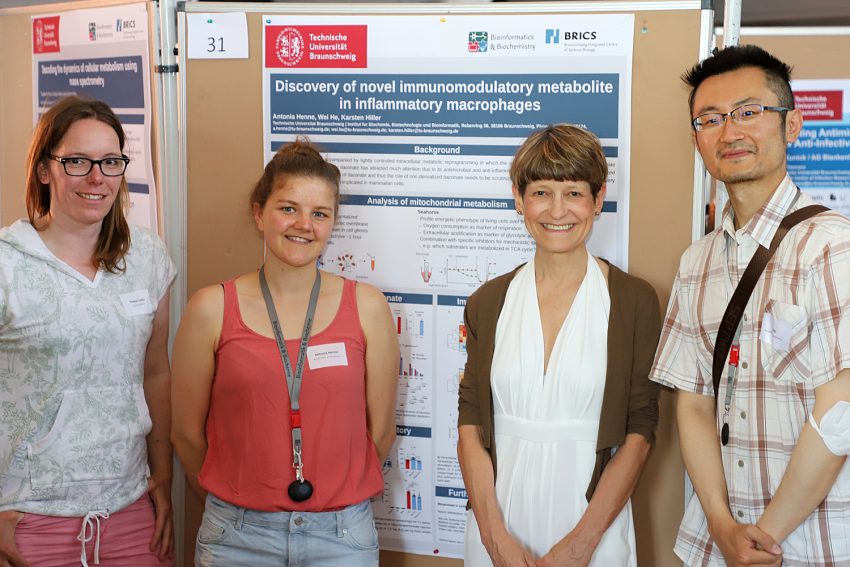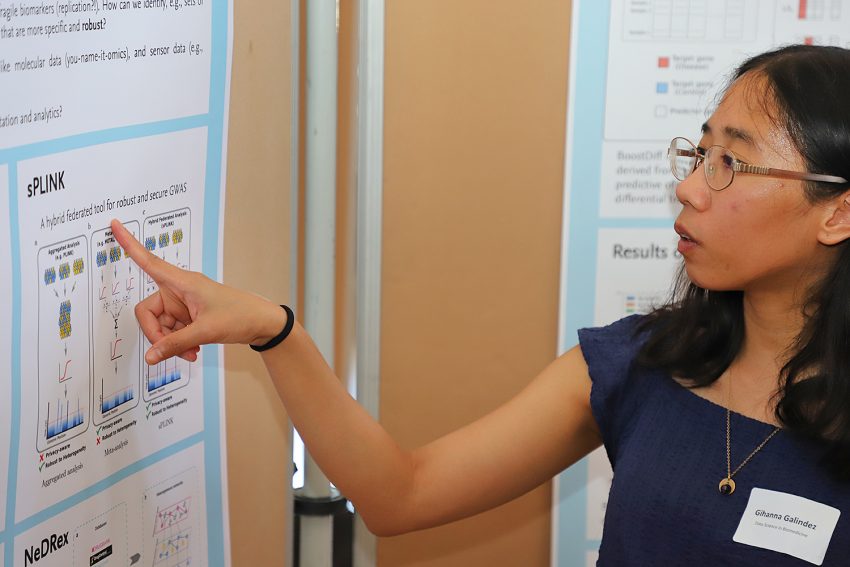Understanding and treating diseases Core Research Area "Infection and Therapeutics“ presents itself at Poster Marketplace
The offer at the Poster Marketplace of the research area “Infection and Therapeutics ” is huge. 40 projects and working groups with a total of 90 participants presented their research here on 19 July and at the same time gave a good overview of the wide range of the research focus. This ranges from research into neurodegenerative diseases to drug targeting and the creation of bioinformatic prognosis models. We took a look around the marketplace and spoke with some of the scientists.

President Prof. Angela Ittel let Prof. Thekla Cordes, Antonia Henne and Dr. Wei He (from left to right) explain their project at the Poster Marketplace. Photo credit: Mark Winter/TU Braunschweig
Neurodegenerative diseases such as Alzheimer’s are widespread diseases. In order to combat them, Dr. Susann Ludewig conducts research in the working group of Professor Dr. Martin Korte. “In our research projects, we want to understand molecular and cellular mechanisms that underlie learning and memory processes in health and disease,” says Dr. Ludewig, describing the research concern in the Neuroinflammation and Neurodegeneration (NIND) WG at the Helmholtz Centre for Infection Research (HZI) and the Cellular Neurobiology WG at the Zoological Institute. “In particular, we are interested in the role of infections and associated inflammatory responses in the progression or even onset of neurodegenerative diseases. Understanding these processes could make it possible to develop therapies and preventive measures for neurological disorders and neurodegenerative diseases in the future.”
The communication between the immune system and the nervous system is the main focus of scientists. For a long time it was assumed that the central nervous system and the immune system act separately from each other. However, studies by the two research groups were able to prove that brains with Alzheimer’s symptoms react more sensitively and strongly to diseases and inflammations, such as sepsis or flu, than healthy brains.
Getting therapeutics to the right place
Drug targeting could also play a role in the therapy of neurodegenerative diseases. “Drug targeting” describes the targeted transport of medical therapeutics to the site of action in the body or in the cells. Nina Baumann and Johanna Pfeifer from the Bunjes working group at the Institute of Pharmaceutical Technology and Biopharmacy are researching this. The Bunjes working group is primarily concerned with the formulation of poorly water-soluble substances. In pharmacy, “formulation” refers to the incorporation of therapeutics into the pharmaceutical form. For example, nanoparticulate drug delivery systems are used for this – i.e. combinations of therapeutics with carrier particles that are to transport them to the target site in the cell. Another way of formulating poorly water-soluble substances is to incorporate them into lipid pellets, whose components disperse finely after application.
Professor Heike Bunjes’ research group is also working on the development and characterisation of implantable formulations for the controlled release of therapeutic proteins. Such implants can help to heal injuries to the musculature. Currently, research is being conducted on an implant that releases growth-promoting proteins to accelerate the regeneration of the tendon-bone junction after a rotator cuff tear in the shoulder.
Finding causes of disease with AI
In contrast, Gihanna Galindez, a research associate at the Peter L. Reichertz Institute for Medical Informatics, has chosen a bioinformatics approach to researching infections and therapeutics. For this, she has developed a new machine learning method for reconstructing a differential network from gene expression data of two patient groups. This can be used, for example, to compare data from diabetics and non-diabetics. The tool then finds out which gene-gene relationships differ between these two groups. “This would give us a better idea of the molecular changes that might be responsible for why diabetics became ill. This could then allow us to find better treatments,” says Galindez. The principle can be applied to many diseases. Data from a wide variety of patient groups can be fed into the software tool and compared with the data sets of healthy people.
“What our lab does is basically data science in biomedicine. We mainly use and develop machine learning and other statistical tools, as well as some network-based analysis of large data sets, to learn more about the causes of diseases. We deal with topics like biomarker identification, patient subtyping and drug repurposing,” Galindez summarises her methodology.

Gihanna Galindez explains the function of a software tool on the Poster Marketplace. Photo credit: Mark Winter/TU Braunschweig.
Networking with posters
In addition to presenting one’s own research, the Poster Marketplace was primarily intended to strengthen networking in the core research area “Infection and Therapeutics” and to stimulate new research collaborations. The researchers should stroll through the market themselves, look at the posters of the other scientists and talk to them. Dr. Anita Remus, coordinator of the research focus and organiser of the Poster Marketplace, is extremely satisfied: “The Poster Marketplace was a complete success. I only received positive feedback.”
The opportunity for networking was also actively used by the scientists: “Some business cards were exchanged and possible further analyses were discussed,” reports Dr. Susann Ludewig. Nina Baumann and Johanna Pfeifer add: “We perceived the Poster Marketplace as a successful event to get to know many other working groups and their research areas in a nice atmosphere. It was exciting to get to know the many different methods and equipment that we work with in our research focus.”
